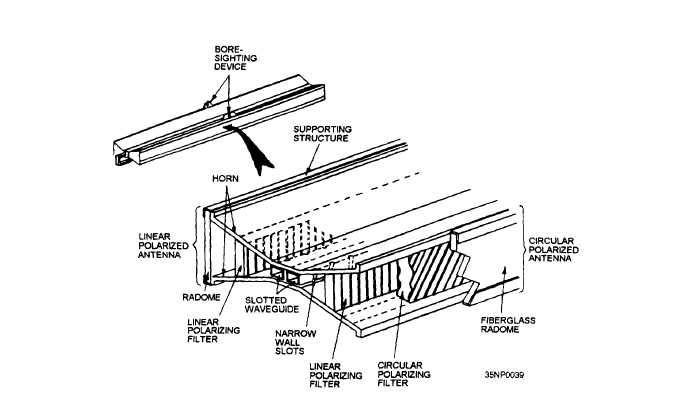The reflector is 24 feet wide and has a
double-curved surface composed of a series of
horizontal members that form a reflecting surface for
the horizontally polarized C-band energy. The antenna
has a 28-dB gain, with a beamwidth of 9 degrees
minimum vertically and approximately 3.3 degrees
horizontally. Antenna roll and pitch stabilization limits
are plus or minus 25 degrees, Stabilization accuracy
is plus or minus 1 degree with the horizontal plane.
The antenna is equipped with a safety switch
located near the antenna pedestal area. The safety
switch disables the azimuth and elevation functions
in the antenna and the radiate function in the transmit-
ter to provide protection for personnel working on
the antenna.
OE-172/SPS-55
The OE-172/SPS-55 antenna group consists of the
antenna and the antenna pedestal. The antenna group
is mast-mounted by means of four bolt holes on the
base of the pedestal.
The antenna consists of two waveguide slotted
arrays mounted back-to-back. One array provides
linear polarization, while the other provides circular
polarization. The array used is selected by means of
a remotely controlled waveguide switch located on
the pedestal. Linear polarization is used for most
conditions. Circular polarization is used to reduce
return echoes from precipitation. Each antenna forms
a fan beam that is narrow in the azimuth plane and
moderately broad in the elevation plane.
Figure 2-47 shows a cross-section of the SPS-55
antenna. During transmission, the rf signal enters the
antenna through a feed waveguide and then enters a
feed manifold region of 80 periodic narrow-wall slots.
The slots are skewed in angle and alternated in
direction of skew. They are separated by approxi-
mately one-half wavelength, resulting in broadside
radiation into the sectoral horn region of the antenna.
The horizontally polarized radiation from the manifold
travels in the horn region toward the aperture, where
it encounters an array of vertical sheet metal slats.
Figure 2-47.—SPS-55 antenna cross section.
2-28


